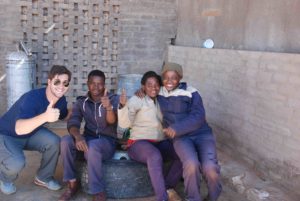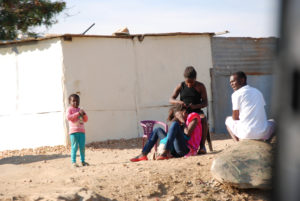Namibia is not a very populated country; however, to my surprise, I’ve discovered there is much diversity within it. Because there is so much diversity within Namibia, a variety of cultures have lasted through the ages. Within the city of Swakopmund, I’ve observed a German influence in their architecture from when Namibia was a colony of Germany. However, besides a German influence, I’ve noticed that those living in cities like Swakopmund and Windhoek have been very kind and friendly, showing their family-like culture and making us feel welcome.

Namibians working on Stampriet Fruit & Vegetable Farm join a member of the Texas A&M Namibia study abroad program for an Aggie Gig ‘em.
Each of the tribes in Namibia have their own distinct culture, belief, and ethnicity. There are eleven distinct ethnicities in this country. A few examples include the Nama, San, Damara, Ovambo, and the Herero. From my research of these cultures, it was interesting to learn the Herero are culturally the most recognizable. Herero have adapted some European influence into their clothes. The women dress in traditional garb consisting of bright colorful ankle-length dresses, high necklines, long puffed sleeves, and a headdress with two points to symbolize cow horns. Herero women still dress like this today, as it is a cultural tradition of their people.
I was surprised by the modern architecture and German influence throughout Namibia. Namibia had been a colony of Germany from 1884 until 1991. Because of this, there has been a heavy German influence through architecture and language throughout the country, most prominently in Swakopmund. However, in Windhoek is the Katatura, which means, “The Place Nobody Wants To Live.”

Four Namibians from Katatura standing around or having their hair braided. These people represent the everyday lives of the people who live in Katatura who can’t afford to live in the cities or are trying to improve their lives.
In Katatura, the architecture was different, showing an entirely different culture to Namibia. Katatura is a very poor part of Namibia where the poverty level is extremely high and the people live in harsh conditions compared to other parts of Windhoek. After visiting Katatura, I saw people living in very small homes made of metal, void of electricity or bathroom, and the locations where people held jobs were made of the same material as their homes.
On July 12, 2017, my classmates and I visited The Namibian Newspaper headquarters. I asked the HR representative of The Namibian to describe the culture of Namibia. She said the closest thing to it would be family. From looking around and seeing the people of Windhoek, I agree there is a family-like culture among these friendly people. On multiple occasions, people would strike a pose when I lifted my camera, allowing me to capture great photos of them. In the end, from touring around The Namibian and seeing the different tribes and cities of Namibia, it became clear, the cultural heritages of Namibia are greatly diverse and have successfully sustained themselves for several generations.